Embracing a gluten-free lifestyle doesn’t mean having to sacrifice flavor or nutrition, especially when it comes to salads. Mediterranean cuisine is renowned for its emphasis on fresh, wholesome ingredients that naturally align with gluten-free dietary requirements. Rich in vegetables, fruits, lean proteins, and healthy fats, it offers a tapestry of textures and flavors that bring both delight to the palate and benefits to well-being.
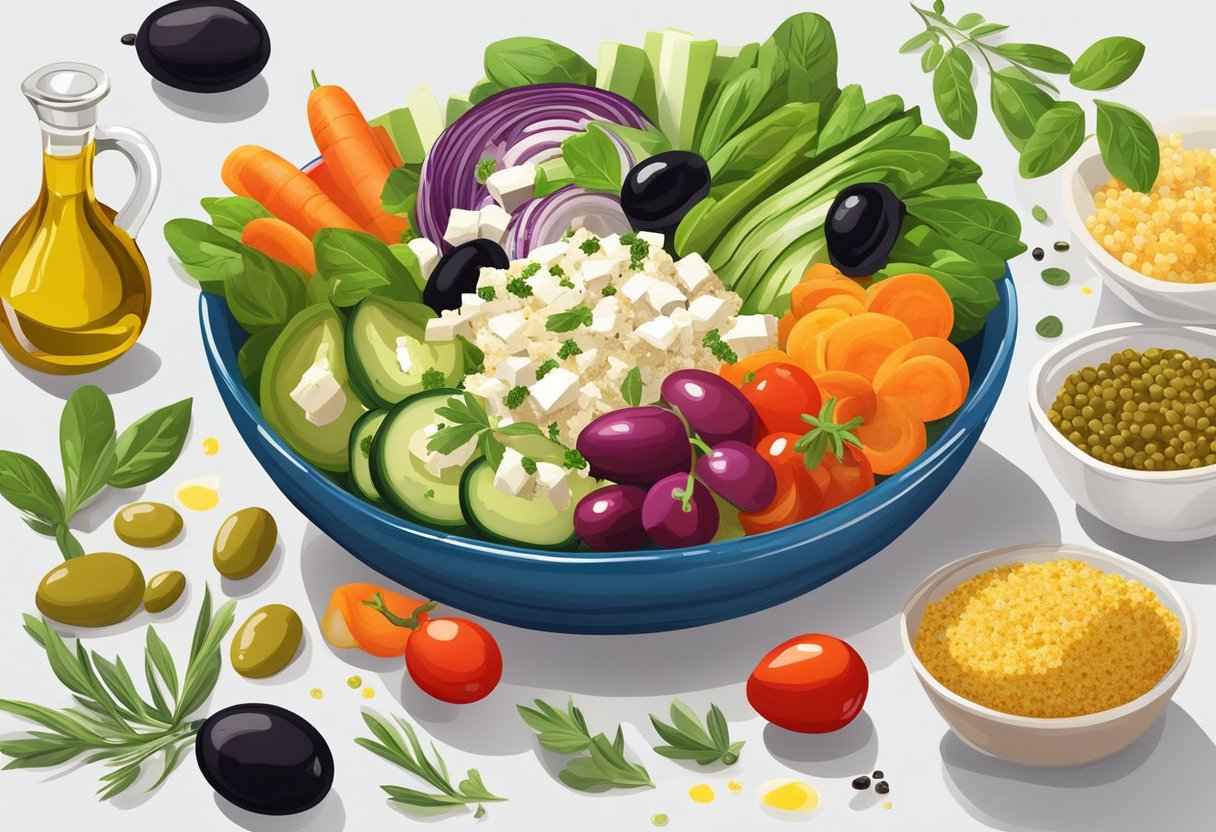
Crafting the perfect gluten-free Mediterranean salad is an art that hinges on quality ingredients and harmonious combinations. Selecting fresh, seasonal produce ensures peak flavor and nutritional value, while incorporating a variety of gluten-free grains, like quinoa or millet, adds substance and caters to those with gluten sensitivities. Equally important is the dressing—heart-healthy olive oil paired with citrus or vinegar creates a simple yet zesty enhancement that ties the salad components together.
Key Takeaways
- Gluten-free Mediterranean salads combine nutrition and flavor without sacrificing dietary needs.
- Selecting quality, seasonal produce and gluten-free grains is crucial for the best salads.
- Simple olive oil-based dressings are ideal for complementing the fresh ingredients.
Table of Contents
Essentials of Gluten-Free Mediterranean Salads
Creating a healthy gluten-free Mediterranean salad involves a symphony of fresh ingredients that align with a Mediterranean diet, known for its heart-healthy benefits and rich flavors. At the core of these salads is gluten-free pasta or alternative grains, paired with an abundance of vegetables, lean proteins, and beneficial fats.
When selecting pasta, one should opt for varieties made from rice, quinoa, or corn that do not contain gluten. These provide a similar texture and taste to traditional pasta, without triggering gluten sensitivities. To ensure the pasta maintains its texture, it’s important to cook it al dente following the package’s instructions.
Ingredients:
- Gluten-free pasta or grains (such as quinoa)
- A variety of colorful vegetables (tomatoes, cucumbers, bell peppers)
- Lean proteins (grilled chicken, chickpeas, tofu)
- Healthy fats (olive oil, avocados)
- Herbs and spices (oregano, basil, mint)
Dressing:
- Olive oil: the mainstay oil in Mediterranean cooking
- Vinegars like apple cider or balsamic
- Citrus juices (lemon or lime)
- Seasonings (garlic, salt, pepper)
Preparation Tips:
- Rinse quinoa thoroughly before cooking to remove the bitter saponin coating.
- Chop vegetables into bite-sized pieces for even distribution and easy eating.
- Incorporate a rainbow of vegetables to maximize nutrient intake.
- For added flavor, grill or roast vegetables before adding to the salad.
A harmonious blend of these elements creates a satisfying salad that encapsulates the essence of the Mediterranean diet while remaining gluten-free and supportive of overall health.
Selecting Fresh Ingredients

When creating a healthy gluten-free Mediterranean salad, selecting high-quality, fresh ingredients is essential to achieve the best flavor and nutritional value. Each ingredient should be picked with care, ensuring that the vegetables and fruits are ripe, the proteins of the highest quality, and the herbs and other flavorings are fresh and aromatic.
Vegetables and Fruits
The foundation of any Mediterranean salad is an abundance of fresh veggies. Look for ripe tomatoes, including cherry and grape tomatoes, which offer a burst of sweetness and a juicy texture. Rich colors often indicate peak ripeness, adding not only to the visual appeal but also to the nutrient content. Cucumbers should be firm and dark green, without signs of wilting. Fresh bell peppers in various colors add crunch and sweetness, while red onions provide a sharp, zesty counterpoint. For citrus zest and tang, a squeeze of fresh lemon cannot be overstated in its importance.
- Tomatoes: Choose deeply colored, firm ones with a bit of give.
- Cucumbers: Select dark green, firm cucumbers and consider English or Persian varieties for a mild taste.
- Red onions: Smaller onions tend to be sweeter, ideal for salads.
- Lemons: Look for a bright yellow color; heavier lemons usually contain more juice.
Quality Proteins
Proteins in a gluten-free Mediterranean salad range from poultry like chicken, to a variety of fish such as salmon and swordfish, and shellfish including shrimp. When choosing meat or seafood, freshness is paramount. For chicken, opt for organic where possible, and ensure it’s well-trimmed. With fish and shrimp, look for clear eyes, clean smell, and firm, glossy flesh. These proteins not only add substantiality to your salad but also contribute essential nutrients and satisfying flavors.
- Chicken: Skinless, boneless breasts or thighs; organic when possible.
- Fish: Fresh or properly thawed, with firm texture and no discoloration.
- Shrimp: Should be translucent and shiny with no strong fishy odor.
Herbs and Flavorings
Herbs and other flavorings are crucial for imparting the characteristic Mediterranean flavors to a salad. Use fresh herbs such as parsley and mint for their bright, clean flavors which beautifully complement the other components of the salad. Kalamata olives lend a rich, salty depth, and should be chosen plump and shiny, with a meaty texture. Always aim for the freshest herbs and olives to ensure the most vibrant taste.
- Parsley: Bright green and not wilted; flat-leaf parsley often preferred for its flavor.
- Mint: Select lush green leaves with no brown spots.
- Kalamata olives: Look for those stored in brine or olive oil for better preservation and taste.
Preparing the Perfect Dressing
Creating the ideal salad dressing is a simple yet crucial element of a healthy gluten-free Mediterranean salad. It can transform simple ingredients into a dish that’s both flavorful and health-conscious.
Oil and Vinegar Combinations
The foundation for many salad dressings, particularly in Mediterranean cuisine, is a well-balanced mix of oil and vinegar. To achieve this:
- Ratio: Use a basic 3:1 ratio of oil to vinegar.
- Olive oil: Opt for extra virgin olive oil for its superior taste and health benefits.
- Vinegar choices: Incorporate balsamic vinegar for a sweet and tangy profile, or red wine vinegar for a classic Mediterranean vinaigrette.
- Lemon juice: For a citrusy zest, lemon juice can be a refreshing substitution for or addition to vinegar.
Adding Herbs and Spices
The inclusion of herbs and spices can elevate a simple dressing to a memorable one. Be sure to:
- Garlic: Crush or mince garlic for a bold flavor that complements the milder oil and vinegar.
- Dijon mustard: A small amount can add depth and help to emulsify the dressing.
- Salt and black pepper: A must for seasoning, adjust according to taste.
- Dried oregano: Dried oregano is a classic Mediterranean herb that infuses the dressing with an earthy, robust flavor.
Combining these components mindfully will result in a dressing that’s both delightful to the palate and aligns with a gluten-free Mediterranean diet.
Gluten-Free Salad Bases
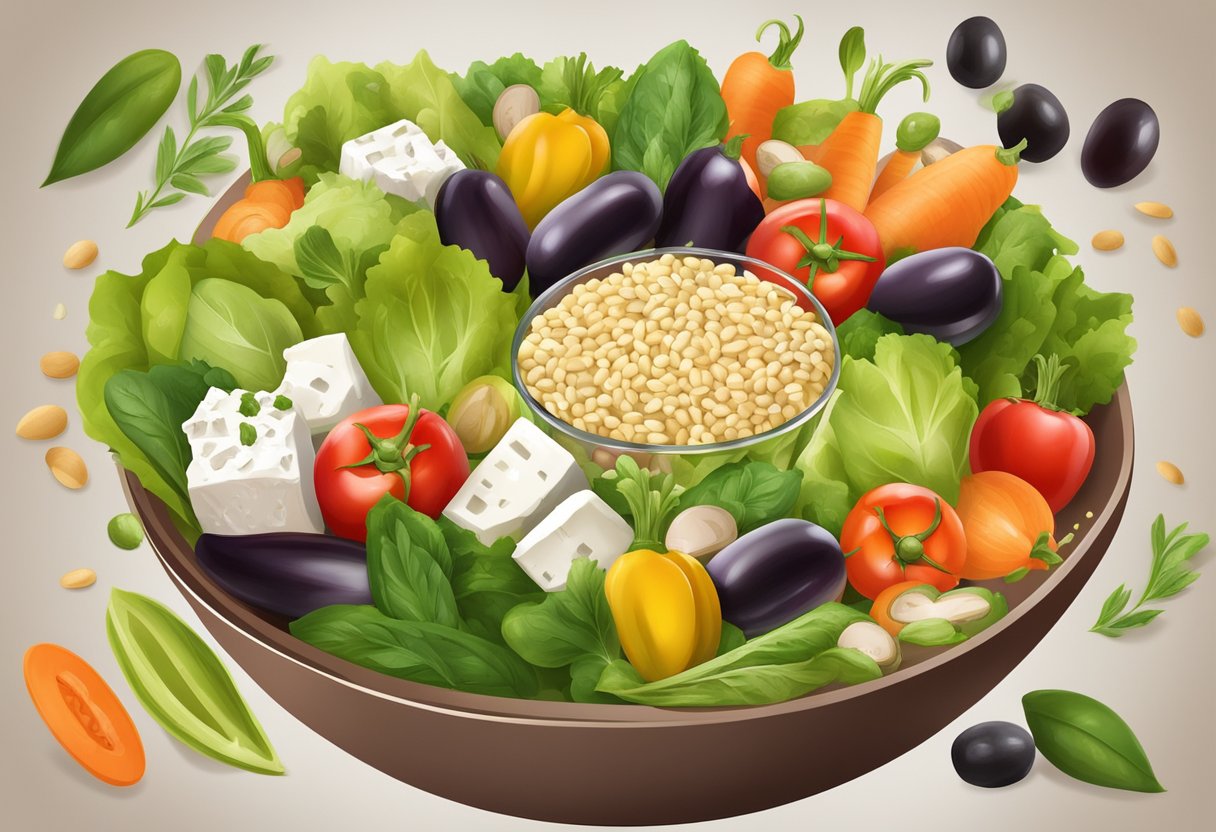
Creating a gluten-free salad base is essential to adhering to a Mediterranean diet without the inclusion of gluten-containing grains. Opting for gluten-free grains and legumes offers a nutritious foundation for a variety of salads.
Using Gluten-Free Grains
Quinoa: A complete protein and excellent gluten-free grain option, quinoa adds a nutty flavor and hearty texture to salads. It’s easy to prepare and pairs well with a range of Mediterranean ingredients.
- Preparation: To cook quinoa, use a 1:2 ratio of quinoa to water and simmer until the grains are fluffy and water is absorbed.
- Nutrition: High in fiber and vitamins, quinoa supports a balanced diet.
Rice: Another versatile grain, rice can serve as a substantial base for Mediterranean salads.
- Types: Choose from brown, black, or wild rice to add not just texture, but also unique flavors to salads.
- Cooking Tip: For a firmer texture in salads, cool the rice after cooking to prevent it from becoming too soft when mixed with dressing.
Incorporating Legumes
Chickpeas: Often found in Mediterranean cuisine, chickpeas are a gluten-free ingredient that adds both protein and fiber to salads.
- Serving Suggestion: Blend chickpeas with herbs and spices for a flavorful addition or use whole for a more traditional approach.
White Beans: Milder in flavor than chickpeas, white beans are a subtle yet nutritious legume choice.
- Pairing: White beans complement a variety of Mediterranean herbs and dressings without overpowering other ingredients.
Gluten-Free Pasta: Made from gluten-free grains like rice or legumes like chickpeas, gluten-free pasta can be incorporated into cold pasta salads.
- Selection: Many shapes and sizes are available to suit any salad style, from fusilli to penne.
- Cooking Advice: Be sure to not overcook gluten-free pasta to maintain its texture in the salad.
Adding Texture and Taste
When crafting a healthy gluten-free Mediterranean salad, the addition of varied textures and rich tastes is crucial. Cheese can introduce a creamy or crumbly texture and a tangy flavor, while nuts and seeds add a crunchy contrast and nutty taste.
Choosing the Right Cheeses
In Mediterranean-style salads, feta cheese is a classic choice. Its crumbly texture and salty tang complement the fresh vegetables commonly found in these dishes. Goat cheese is another excellent option, offering a creamy consistency and a mild, tangy flavor profile that pairs well with a range of ingredients.
Mixing in Nuts and Seeds
To enhance the texture further, chefs often sprinkle salads with nuts and seeds. Each variety contributes a unique crunch and flavor. For instance, toasted pine nuts or slivered almonds impart a subtle nutty flavor, which harmonizes with the existing Mediterranean elements without overpowering them.
Recipe Variations
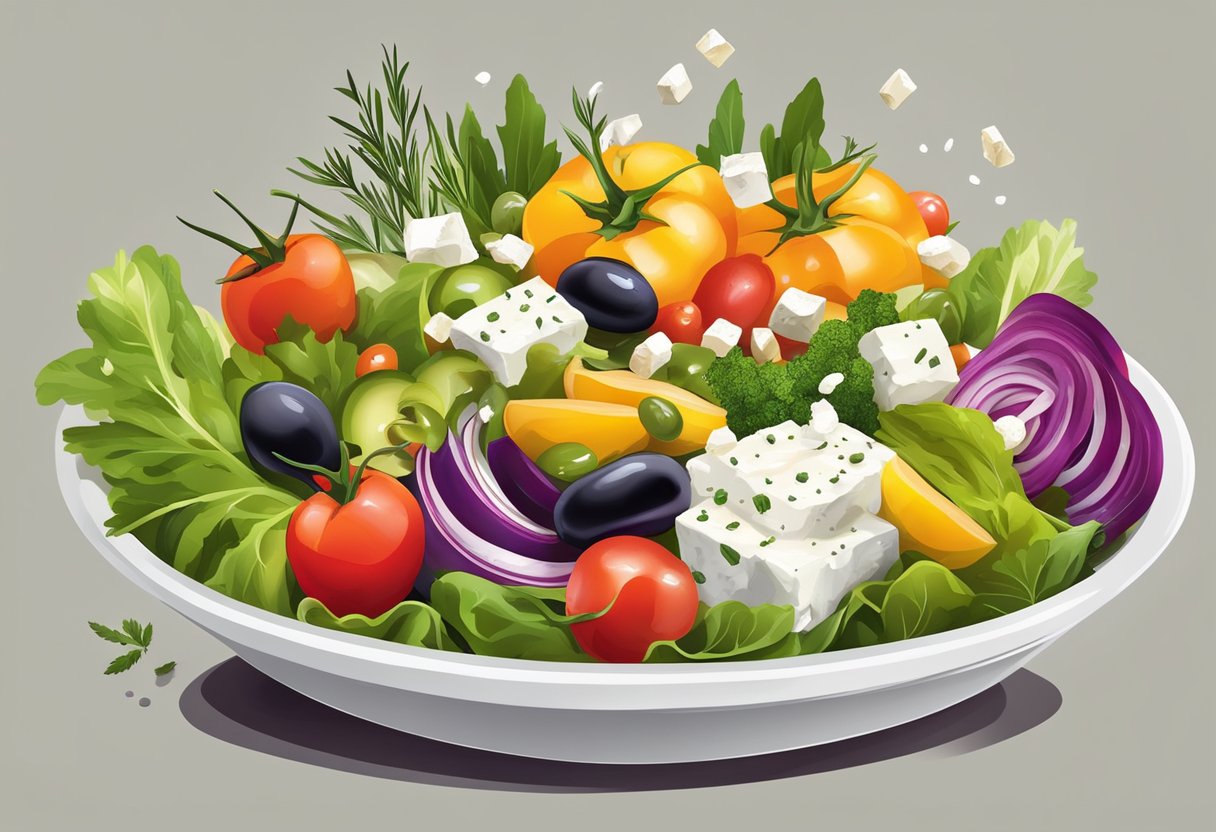
Exploring recipe variations for gluten-free Mediterranean salads is essential for those looking to maintain a healthy diet without sacrificing flavor. These variations cater to different dietary needs while celebrating the rich tapestry of Mediterranean cuisine.
Mediterranean Pasta Salads
Gluten-free Mediterranean pasta salads offer a harmonious blend of taste and nutrition. Opt for gluten-free pasta options such as quinoa or chickpea pasta as a base for a Greek Chickpea Pasta Salad, incorporating classic ingredients like cucumbers, tomatoes, and olives along with a tangy dressing. One can enrich the salad by adding hummus or feta cheese, ensuring a protein-packed and satisfying meal.
Hearty Chicken and Fish Salads
Chicken and fish can elevate gluten-free Mediterranean salads into substantial, meal-worthy dishes. For a hearty option, a salad featuring grilled chicken breast, seasoned with herbs like rosemary and thyme, adds lean protein. Alternatively, a flaky seared salmon filet atop a bed of mixed greens embodies the quintessential Mediterranean Sole flavors, with both dishes allowing for additional vegetable toppings of one’s choice.
Vegetarian and Vegan Options
Vegetarian and vegan variations are integral to gluten-free Mediterranean salads. A protein-rich Greek Salad with Edamame provides a refreshing choice, combining traditional ingredients with edamame for a unique twist. For those embracing a vegan diet, create a vibrant quinoa salad teeming with vegetables and a lemon-infused olive oil dressing, or savor a robust chickpea salad bursting with spices and fresh herbs.
Complementary Side Dishes

When enjoying a gluten-free Mediterranean salad, pairing it with the right side dishes can enhance the dining experience. These additions should complement the flavors and textures of the salad while adhering to a gluten-free diet.
Gluten-Free Breads and Crackers
Gluten-free pita bread offers a delightful texture and is a traditional accompaniment in Mediterranean cuisine. It can be toasted for added crunch and served with spreads like hummus, which provides a creamy contrast to crisp, fresh veggies in the salad. Additionally, a variety of gluten-free crackers made from alternative flours such as almond or coconut can provide a satisfying crunch.
Refreshing Vegetable Sides
Aside from bread, serving fresh vegetable sides provides a refreshing palate cleanser. Grilled asparagus or zucchini brushed with olive oil and herbs not only adhere to a gluten-free diet but also add a smoky flavor. A simple side of mixed fresh veggies, such as bell peppers and cucumbers, can be seasoned lightly to enhance their natural taste, making them a refreshing complement to any Mediterranean dish.
Serving and Presentation Tips
When serving gluten-free Mediterranean salads, presentation can elevate a simple dish to a culinary masterpiece. These salads are versatile enough to serve as a side dish or to stand alone as a healthy lunch or filling dinner option.
For meal prep, salads can be layered with dressing on the bottom to maintain freshness. Consider mason jars for a visually appealing and practical solution. One should always add the dressing just before serving to avoid a soggy salad.
Lunch servings are typically lighter; thus, utilizing a variety of colorful vegetables can add vibrancy without heaviness. A neatly arranged platter with hummus or tzatziki on the side can enhance both taste and appearance.
When presenting these dishes for dinner, place the salad in a large, shallow bowl to display the ingredients. Components like riced cauliflower, which can work well in place of grains, provide a satisfying base without gluten. Ingredients such as chickpeas, olives, or artichoke hearts contribute to a robust profile and eye-catching garnishes.
Table 1: Ingredient Layering for Visual Appeal
| Base Layer | Middle Layer | Top Layer |
|---|---|---|
| Riced cauliflower | Chopped tomatoes | Diced cucumbers |
| Mixed greens | Sliced onions | Chickpeas |
| Quinoa | Bell peppers | Fresh herbs |
For a truly tasty experience, consider toasting nuts or seeds for a bit of crunch. A sprinkle of feta cheese, if dietary preferences allow, can also add a dash of richness.
When dressing a salad, do so lightly to let the natural flavors shine. A simple mixture of olive oil, lemon juice, salt, and pepper can be whisked and drizzled over the top.
By adhering to these serving suggestions, one can confidently present a healthy, gluten-free Mediterranean salad that is as delightful to look at as it is to eat.
Maintaining a Balanced Diet
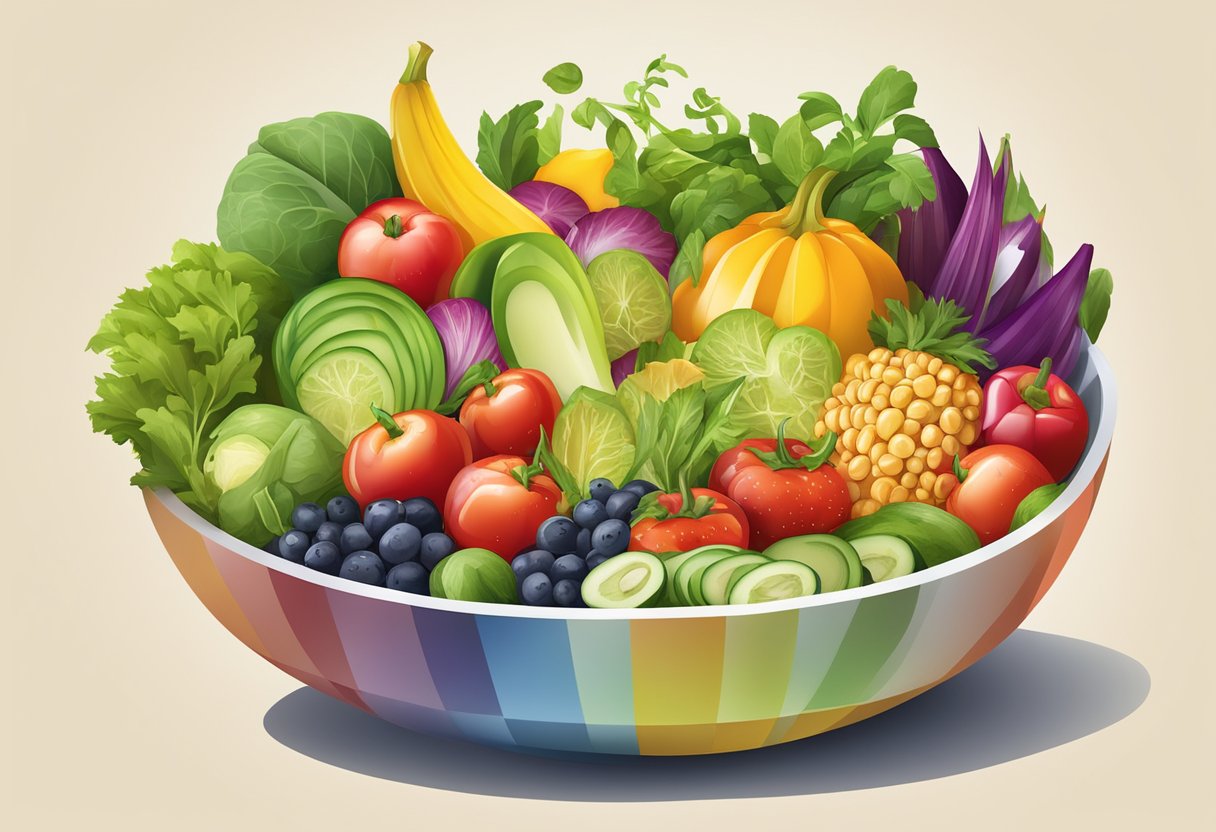
A balanced diet is crucial for good health, and salads play a significant role, particularly in a gluten-free Mediterranean lifestyle where meal prep and nutrition info are emphasized.
The Role of Salads in Nutrition
Salads are a staple in the Mediterranean diet, celebrated for their high fiber content and rich nutritional profile. They typically include a variety of fresh vegetables, fruits, nuts, and seeds—all of which contribute to the overall fiber intake. This can lead to better digestive health and a feeling of satiety, which is helpful for weight management. Including gluten-free grain alternatives such as quinoa or buckwheat adds to a salad’s nutrient diversity by providing essential vitamins and minerals.
Integrating Salads into Weekly Meal Planning
Meal Prep: To ensure a consistent, healthy diet, individuals can incorporate salads into their weekly meal planning. By preparing ingredients ahead of time, they make it easier to assemble nutritious salads during the week.
- Grocery List:
- Vegetables (spinach, kale, arugula)
- Fruits (tomatoes, cucumbers, bell peppers)
- Gluten-free grains (quinoa, buckwheat)
- Proteins (chickpeas, lentils, grilled chicken)
- Healthy fats (olive oil, avocados)
Nutrition Info: Keeping track of nutrition information helps maintain a balanced intake of calories and nutrients. Salads in a Mediterranean diet provide a well-rounded source of nutrition, and being mindful of portion sizes and dressing choices ensures they remain a healthy part of the diet.
Storing and Managing Leftovers
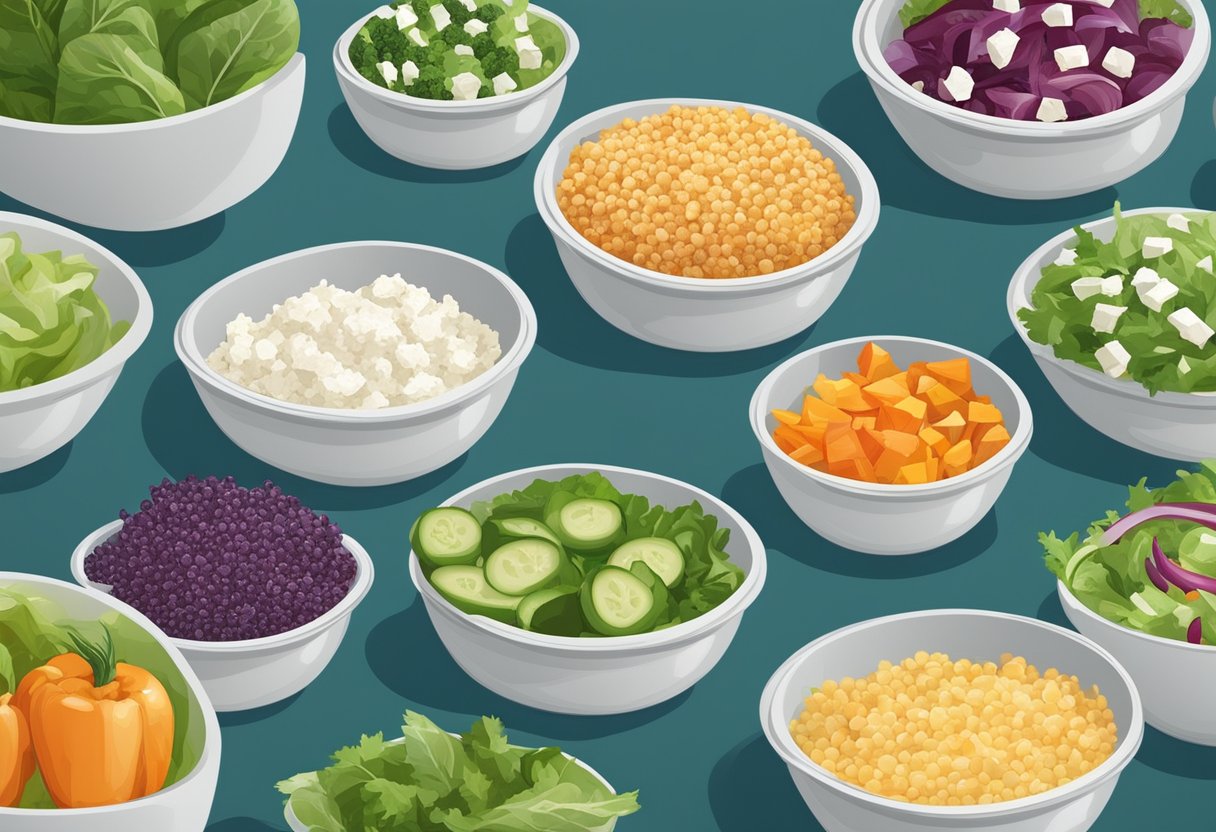
When it comes to preserving the freshness and health benefits of leftover gluten-free Mediterranean salads, proper storage is key. Salads should ideally be stored in airtight containers to maintain their crispness and prevent any contamination.
Refrigeration: Leftovers must be refrigerated within two hours of serving. They can be kept in the fridge for up to 3-5 days, depending on the ingredients used. It’s important to note that salads with dressings or dairy components should be consumed sooner to avoid spoilage.
Container Selection:
- Use glass containers, which can help keep the salad crisp.
- Opt for shallow containers that allow for the cooling of ingredients evenly.
For dressings:
- Store salad dressings separately when possible.
- This helps to ensure that the salads do not become soggy over time.
If the salad contains ingredients like avocados or tomatoes, it’s best to add these fresh when serving the leftovers, as they can become mushy when stored.
Freezing: Freezing is not recommended as it can greatly affect the texture and taste of a Mediterranean salad.
Heating: Typically, Mediterranean salads are enjoyed cold. Any ingredient that requires reheating should be stored separately and added after heating.
By following these storage guidelines, one can ensure that their leftover gluten-free Mediterranean salads remain as healthy and delicious as when they were first prepared.
Frequently Asked Questions
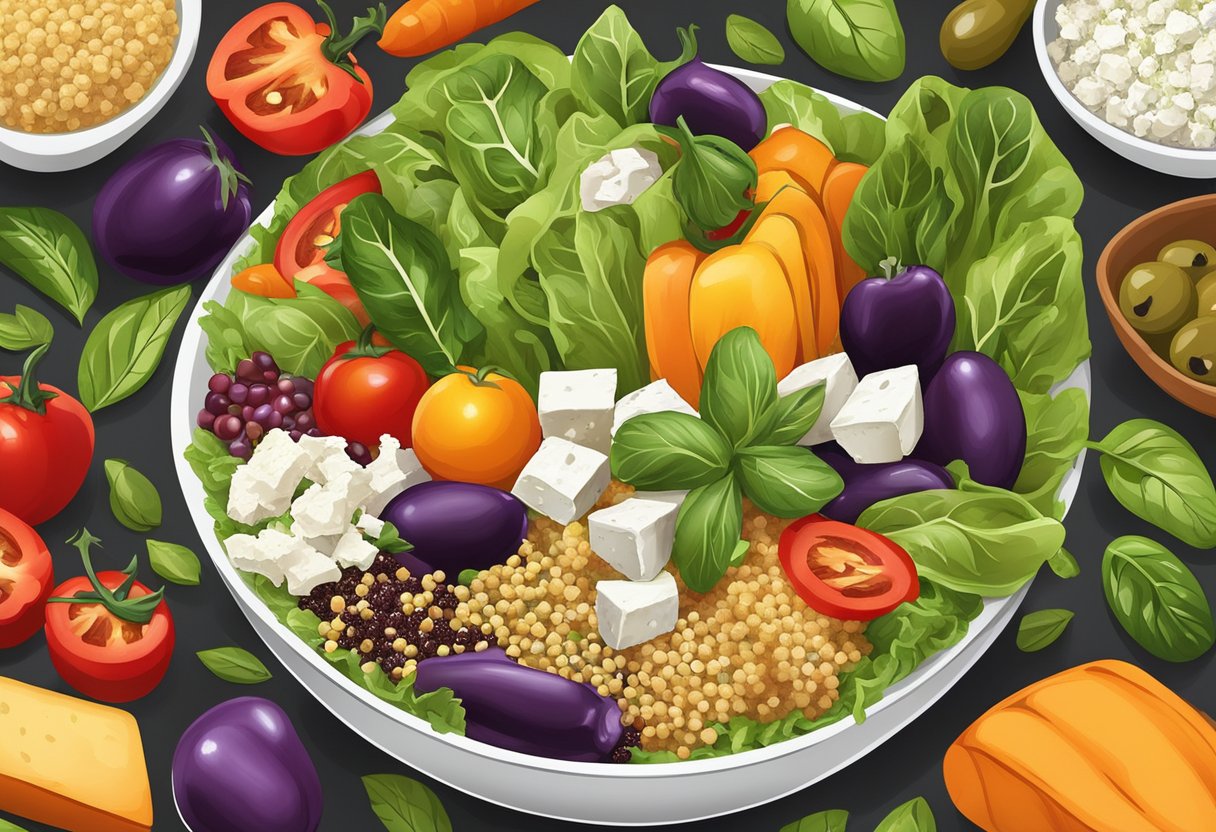
In this section, readers will find answers to commonly asked questions regarding the preparation and choices of gluten-free Mediterranean salads.
How can I ensure Greek dressing is gluten-free?
To ensure Greek dressing is gluten-free, one must carefully read the ingredients list for potential gluten sources like wheat, barley, and rye. Opting for labeled gluten-free versions or making homemade dressing with olive oil, lemon juice, and herbs can offer peace of mind.
What are some plant-based ingredients commonly used in Mediterranean salads?
Plant-based ingredients frequently found in Mediterranean salads include chickpeas, which provide a protein-rich and gluten-free option, a variety of fresh vegetables like cucumbers and tomatoes, and healthy fats such as olives and avocado.
Can you suggest vegetarian salad options that are both gluten-free and Mediterranean-style?
Vegetarians can enjoy a gluten-free Mediterranean salad featuring quinoa or chickpea pasta, along with classical elements like feta cheese, olives, and a hearty mix of vegetables topped with a tangy, gluten-free dressing.
What are some healthy gluten-free Mediterranean salad recipes?
Healthy gluten-free Mediterranean salad recipes blend nutrient-dense vegetables with gluten-free grains like quinoa, and combine them with ingredients such as lemon, olive oil, and fresh herbs for flavor.
Which Mediterranean salads are recommended for weight loss while being gluten-free?
Mediterranean salads conducive to weight loss and gluten-free diets incorporate lean proteins, vegetables, and legumes without added gluten-containing croutons or wheat-based ingredients. Salads with a base of leafy greens or chopped vegetables are ideal options.
How can I make a gluten-free Mediterranean Quinoa Salad suitable for a BBQ?
To make a gluten-free Mediterranean Quinoa Salad suitable for a BBQ, one can grill vegetables like zucchini and bell peppers before adding them to the salad, ensuring a smoky flavor that complements the quinoa and fresh Mediterranean ingredients.



